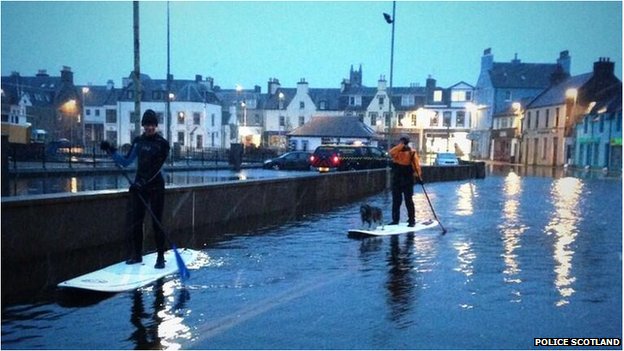
November 28, 2014, by James
Sources in focus – Newspaper reports of extreme weather in and around Stornoway and the Western Isles in the nineteenth and twentieth centuries (part 1).
Sources in focus – Newspaper reports of extreme weather in and around Stornoway and the Western Isles in the nineteenth and twentieth centuries (part 1).
Since the project started in December 2013, blogs have highlighted several categories of historical sources which can provide evidence of past extreme weather events, for example, diaries and parish registers. In my final blog for 2014, I would like to explore newspapers which are a fascinating source for incidences of extreme weather in the nineteenth and twentieth centuries, particularly those concerning a locality or region. The northwest Scotland case study region, more specifically the Outer Hebrides has been chosen for investigation by the project as it has been identified as being at risk of flooding and storm events. But what was the impact of extreme weather in the past for the isolated island communities of the Hebrides? To what extent were the lives of islanders affected by weather events, for instance with regard to the economic activities, such as, crofting and fishing, and also lifeline transport links, such as, the ferry services connecting the islands with the mainland? This blog focuses on three newspapers: the ‘Highland News’, the ‘Stornoway Gazette’ and ‘The Scotsman’ for the periods 1883-1923, 1917-2004 and 1845-1950 respectively which have been indexed, a copy of which has been provided by David Powell, formerly archivist at Tasglann nan Eilean Siar – Hebridean Archives.[1] It explores three themes showing the impact of extreme weather on ferries and shipping; fishing; flooding and high tides. Lastly, consideration will be given to other weather extremes recorded, specifically thunder, lighting and snowstorms.
The impact of extreme weather on ferries and shipping
There are many references to the disruption of lifeline ferry services to the remote Outer Hebrides. For instance, it was reported on the 10 December 1966 that: ‘Bad Weather Hits Mail Service’ as force 10 gales delayed the mail boat ‘Loch Seaforth.’ In January 1974 there was much anger over the cancellation of sailings from the Isle of Lewis. On the 12 January 1974 it was reported that many people travelling between Lewis and the mainland over Christmas and New year expressed their anger and dismay at the non-sailing or the delayed sailings of the ferry M.V. Clansman which resulted in passengers being stranded in Lewis or Ullapool during the festive season (Stornoway Gazette, 12 January 1974). A spokesman for Caledonian MacBrayne said: “The ferry missed three sailings between December 21st and January 5th (apart from when the service was suspended for the statutory holidays) because of the weather conditions.” The following week it was reported that the so-called: ‘No Go Clansman’ had sailed in a force eleven gale. D. Campbell, Chief Steward-Purser in a letter to the editor wrote: ‘one must surely concur that there can be no doubts about her sea worthiness or stability or that any of the crew are afraid to sail her.’ Furthermore, Campbell who being a member of the ship’s crew had obviously come in for criticism wrote: ‘Contrary to what Provost Matheson and his satellites believe, the Masters who sail the Clansman have the welfare of the travelling public very much at heart and have no wish to inconvenience anyone. Surely it is time for a little praise for the officers and men who sail the ship in such hazardous weather and conditions instead of the unwarranted innuendo in the press.’ (Stornoway Gazette, 19 Jan 1974).
On the 12 April 1975 the newspaper reported a ‘Terrifying trip on the Suilven’ with the crossing from Ullapool to Stornoway lasting five hours due to bad weather. The following year there were no landings at Ullapool at the time of going to press because of a combination of bad weather and the inadequacy of the pier which prevented the ‘Clansman’ from berthing there at any point that week (Stornoway Gazette, 24 January 1976). On the 11 November 1978 it was reported that a group of children from Sale in Cheshire who were holidaying near Ullapool and had taken the ferry ‘Suilven’ to Stornoway were stranded overnight because of bad weather. They were housed at a school hostel overnight (Stornoway Gazette, 11 November 1978). Other ferries were disrupted by storms. In the winter of 1975 the Scalpay boat, ‘Village Maid’ was caught in a storm off the West Coast of Harris (Stornoway Gazette, 15 March 1975) and again in March 1988 a storm stranded the Scalpay ferry (Stornoway Gazette, 31 March 1984). Also in 1988 gale force winds caused three barges (two of them Dutch) that were moored at Arnish and scheduled to leave the next day, to break free from their moorings just as the Stornoway ferry, the ‘Suilven’ was approaching the harbour. The ferry waited outside the harbour for nearly an hour until the weather calmed down and it was safe to enter.

Photographs of the Caledonian MacBrayne ferry, M.V. Suilven. There is a youtube video which shows the M.V. Suilven in service with Strait Shipping in New Zealand to whom she was sold by Calmac in 1995 . She operated a service between Wellington and Picton, before being transferred to the Wellington to Nelson service in late 2002. She was sold in April 2004 and is now based in Fiji.
In addition to ferries, there are early references to the effects of extreme weather on shipping more generally. In January 1873 six men were lost when their boat encountered a storm in the Minch, a strait separating the north-west Highlands and the northern Inner Hebrides from Lewis and Harris in the Outer Hebrides (The Scotsman, 21 January 1873). In 1893 the Channel Fleet, manned by 4000 men (which consisted of seven ships ‘Speedwell’, ‘Barossa’, ‘Blenheim’, the flagship ‘Royal Sovereign’, ‘Empress of India’, ‘Resolution’ and ‘Repulse’, the latter four being battleships, and a further ship named the ‘Endymion’) visited Stornoway for several days. The weather throughout the day (Saturday) was very stormy, with only one boat being launched to take the mail ashore. On Monday, however, the weather improved and MacBrayne’s steamer ‘Claymore’ made two trips round the fleet carrying on the first occasion approximately 500 passengers, although there were only about 100 passengers on the second trip. In 1900 a Norwegian brig called the ‘Enighaden’ cast anchor in Stornoway harbour after passing through a storm. It was on passage from Alloa to Drammen laden with coal. After seventeen days at sea and having reached within forty miles of her destination, she was blown right across the North Sea, between the Orkney and Shetland Isles and only made Stornoway harbour with the greatest difficulty, the crew being exhausted (Highland News,6 January 1900). Later in September there was another report of a terrible experience at sea, this time the steamer ‘Bear’ carrying sheep from Iceland to Liverpool was caught in a storm. Her steering gear broke. Of the 2600 sheep loaded, 2000 were lost either due to suffocation when the holds were closed, or because those on the open deck were thrown overboard for the ship’s safety (Highland News, 29 September 1900).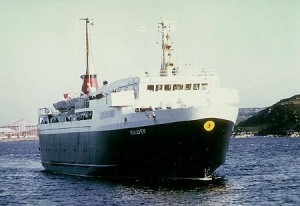
In 1905-6 there were several gales and storms reported in the Highland News. For example on the 4 April 1905 a fierce gale with hurricane force winds blew for three hours then abated as suddenly as it had developed. A mail steamer arrived at eight o’clock at the height of the storm, but could not come alongside at Stornoway for two hours – she left in the evening at the usual time of 11 pm. A temporary church building at Crossbost was also demolished by the storm (Highland News, 4 April 1905). In February 1906 a steamer called ‘Battle Isle’ of Glasgow which was engaged in carrying herrings from Stornoway to the railway terminus at Mallaig, whilst leaving Stornoway harbour at about nine o’clock in the evening, tried to avoid collision with an inbound steamer and in doing so went ashore on the west side of Goat Island. The ship’s cargo of fish was transferred to another steamer and attempts to re-float the vessel were unsuccessful. It was feared an impending storm would result in serious damage (Highland News, 17 February 1906). Later in May a heavy gale which blew from the north developed and continued all day. It intensified during the night, gaining in force and raging unabated the following day. It was reported that the storm brought fishing to a standstill, the fleet being unable to put to sea. Some of the boats that had been out fishing on the Wednesday had been unable to haul their nets due to the high sea and several which had returned to harbour reported serious loss of gear, with one boat losing forty nets. The return of the boats that were still out fishing was anxiously awaited. It was also reported that the mail steamer ‘Sheila’ encountered terrific weather whilst crossing the Minch. The Leith cargo and passenger steamer ‘St Clair’ left for Aberdeen early on Thursday morning and was unable to proceed further than Tiumpan Head and had to return to harbour at Stornoway, where she lay weather bound. Other steamers, having discharged their cargoes, were unable to leave port until the weather moderated. It was observed that accompanying the storm was heavy rainfall with occasional showers of hail, as well as it being bitterly cold (Highland News, 19 May 1906).
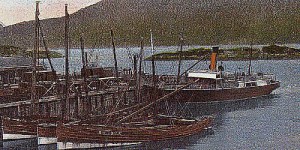
The steamship Sheila was launched Saturday, 30/01/1904 at A & J Inglis Pointhouse Glasgow and completed in 1904. She was wrecked when the vessel ran ashore in darkness in Cuaig Bay just south of the mouth of Loch Torridon, 1 January 1927.
In 1927 it was reported that the steamer ‘Sheila’, which belonged to David MacBrayne Ltd. and had a gross tonnage of 256 and a net of 97 tonnes, previously referred to, was abandoned during a trip between Stornoway and Kyle of Lochalsh during a heavy north-easterly gale.[1] It had grounded near Cavig, Applecross at four o’clock in the morning on 1 January 1927. The passengers and mail were landed safely whilst the crew remained on board the flooded and badly damaged vessel (Highland News, 8 January 1927). The ‘Sheila’ had left Stornoway in the early hours of Saturday morning and at around six o’clock the passengers were alarmed by a crash as the vessel ran ashore. It was reported that nothing could be done in the darkness, and that the crew waited for daylight as the vessel was leaking. When morning broke they found that the vessel was fast on a beach strewn with boulders, whilst beyond the shore the land rose steeply to a height of 50 feet. On looking seaward it was found they had just missed a chain of partially submerged rocks. The newspaper report continues describing how given the steamer lay at an angle of 48 degrees, the port lifeboat was launched and the half dozen passengers with some of the crew and mails were put into her. The passengers were landed while the crew stood by the vessel to see what they could do to get her afloat. The passengers made their way to the nearest habitation which proved to be the farmhouse of Reaulay, Arrian, tenanted by Mr Michael Macrae, who made them welcome until four o’clock the following day when a relief steamer, the ‘Plover’, arrived from Gairloch and took them to Kyle of Lochalsh from where the passengers continued their journey by train. It was noted that during their stay at the farmhouse, the passengers were unable to communicate with the outside world as the nearest post office was fifteen miles away.
Gales and storms often meant that travel around the Outer Hebrides was disrupted. On the 3 November 1959, scientists were reported as being stormbound on the island of Rona as a severe gale hit the Hebrides (Stornoway Gazette, 3 November 1959) and in November 1961 bad weather stranded Allan Montgomery, a Stornoway based engineer, for eleven days on the island of St Kilda which he was visiting in order to fix a fridge (Stornoway Gazette, 24 November 1961). On the 26 January 1962 there was further disruption caused to travellers. George Whitaker, a Sanitary Inspector, described how a storm on the overnight crossing of the Minch on the ‘Loch Seaforth’ meant that it was late arriving in Kyle of Lochalsh at 6.15am. Unfortunately the connecting train had left the station shortly after 6am on the orders of Inverness. Dock workers claimed that the vessel was opposite the Lochalsh Hotel when the train departed with only two passengers on board. There were at least a dozen passengers on the ferry that were intending to continue their journey by train (Stornoway Gazette, 26 January 1962). More recently, in 1966 a storm damaged a freighter called the ‘Torsholm’, which was forced to call in at Stornoway for repairs after being subjected to hurricane force winds (Stornoway Gazette, 3 December 1966). In 1997 there was a tug alert as a super-tanker drifted in a storm off the Hebrides. Consequently there was pressure on the Coastguard to have a tug available all year round at Stornoway (Stornoway Gazette, 6 March 1997). Controversially, the Stornoway coastguard tug was withdrawn in 2012.[3]
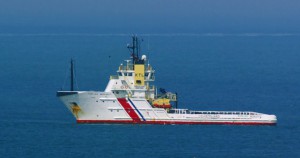
Photograph of the Emergency Towing Vessel (ETV) Anglian Monarch that was chartered by the Maritime and Coastguard Agency (MCA) and based at Stornoway for use in pollution control and the towing of vessels that were in difficulty. It was withdrawn in 2012.
An important asset to any coastal and maritime community is the Royal National Lifeboat Institution (RNLI) lifeboat.[4] Newspapers often record the launching of the lifeboat with whom the local population had a close affinity, being crewed by volunteers and paid for through fundraising activities. In 1894 the lifeboat was launched during a severe gale which was the worst experienced for the past twelve years (Highland News, 20 January 1894). The Stornoway Gazette also reported that the RNLI made rewards of £1 17s. 6d. to each member of the crew of the Stornoway lifeboat for rescuing fifteen lives in a strong gale on the 15 January 1943. The fifteen men had abandoned their vessel and landed on a nearby island. No other boat could face the weather, so the lifeboat was called out and approached from the sheltered side of the island (the lee) and recovered the men. More recently, in 1987 the headline: ‘Lucky to be alive as yacht hits storms’, recalls the experience of the crew of ‘Erdsamus’, a yacht from Canada which was towed into Callanish after a month-long voyage from Greenland (Stornoway Gazette, 19 September 1987). For a video of the Stornoway coastguard helicopter and the Stornoway RNLI lifeboat conducting training at night in a moderate swell see: https://www.youtube.com/watch?v=KckhH2xoUYY, accessed 24 November 2014.
This blog continues in part two, exploring the impact of extreme weather on fishing; flooding and high tides; thunder, lighting and snowstorms.
References
- [1] For the blog of Tasglann nan Eilean Siar – the Hebridean Archives service see: http://blogserver.cne-siar.gov.uk/wp-archivist/, accessed 24 November 2014.
- [2] For information about the S.S. Sheila see: http://www.clydesite.co.uk/clydebuilt/caledonian-macbrayne/SHEILA_275.html, accessed 24 November 2014.
- [3] See: http://www.hebrides-news.com/stornoway-coastguard-tug-removed-19312.html, accessed 24 November 2014.
- [4] Founded in 1824 as the National Institution for the Preservation of Life from Shipwreck, the RNLI was granted Royal Charter in 1860 and is a charity in the UK and Republic of Ireland. Queen Elizabeth II is Patron.

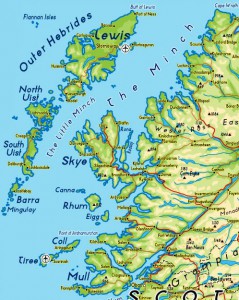
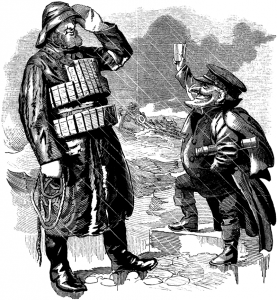
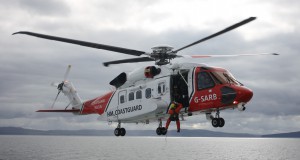
[…] of extreme weather in the Western Isles in the nineteenth and twentieth centuries’ part 1 (https://blogs.nottingham.ac.uk/weatherextremes/2014/11/28/sources-in-focus-newspaper-reports-of-extre…😉 explored the impact of extreme weather on ferries and shipping. Following on part 2 examines […]
Great article loved it.
Very nice indeed!